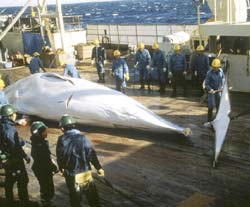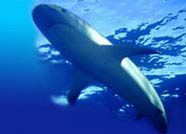|
 Why
is Shark Hunted? Why
is Shark Hunted?
Sharks are a vital component of our oceans, and feed on a wide variety
of fish, shellfish and mammals. The oceans remain healthy because every
organism in it is part of a complex food web. When any component of this
web is removed the balance in the system is altered. Sharks are involved
in several steps of this web including, feeding on the sick and dying,
and feeding on larger animals such as whales, seals and tuna, which have
few predators.
Today sharks are fished and hunted for their meat, fin, oil, sport etc.
Their number is deploying at a speeding rate. Following factors can be
looked upon as a cause for this depletion:
- Bycatch: Sharks are frequently caught in trawler nets or
on long line hooks that are set for tuna or swordfish. Sharks are
highly migratory and they often swim in-groups that are the same size
and age. This can mean that a key part of the population (mature females
for example) can be wiped out in one fell swoop. Estimates vary, but
Bycatch (unwanted catch) accounts for a significant proportion of
shark fatalities.
- Shark fin soup: Around 100 shark species are deliberately
targeted by the fishing industry. Shark fins are highly prized for
use in shark fin soup, a high status dish that can sell for £65
a bowl, especially in Asian countries where growing wealth has increased
demand. As demand is met, sharks become overfished, fins are harder
to come by and the soup is therefore even more of a status symbol.
Conservationists estimate that about 100 million sharks are caught each
year, many of them purely for use in shark fin soup. Hong Kong alone
imported the fins of more than 28 million sharks in 1999. The sharks
are caught, their fins are cut off and they are then thrown back into
the sea where they either bleed to death or drown. Using DNA, it is
now possible to identify shark species from their fins, a development,
which may be significant in monitoring the impact of this trade.
- Shark meat: Demand for shark meat is booming. It is now possible
to buy it in supermarkets in Europe (including the UK), South America
and the USA. The shortfin mako, which is said to provide the best
shark meat is classified as lower risk, but vulnerable species such
as the porbeagle shark, is also taken. This trend may be indicative
of the fact that so many other fish species are declining and that
people have been encouraged to eat fish as a healthy alternative to
meat. The Food Standards Agency, however, has advised against giving
children shark meat to eat because of high levels of methylmercury
that can damage the nervous system.
- Shark skin and oil: Shark skins can be tanned and used as
an alternative to leather (for belts, boots, bags, etc). In theory
and on a small scale, this could be a useful by-product of a sustainable
and managed fishery. In practice, the impact on shark populations
has yet to be assessed or monitored. Sharks have traditionally been
fished for oil. Squalene is extracted from shark livers and used as
a lubricant and in cosmetic and pharmaceutical products. It can take
up to 3,000 shark livers to produce one tonne of squalene.
- Shark cartilage: Sharks are cartilaginous - they have cartilage
instead of bone. The cartilage is used in traditional medicines and
is sold in powder or capsule form as a cancer treatment. There is
no scientific evidence to suggest that it is in any way effective
against the disease and the 'medicine' can be very expensive. There
may, however, be other benefits in maintaining shark biodiversity,
for example, shark cartilage has also been used in the development
of a synthetic skin for burn victims.
- Breeding age: Sharks have evolved over 450 million years
to be among the ocean's top predators. They can take many years to
reach sexual maturity, almost 30 years in the case of the sand bank
shark. Larger sharks may only produce two young in a breeding cycle
and only one of those is likely to survive. Shark species often only
breed every other year and some have a long gestation period (up to
two years). This low reproductive rate means that depleted shark populations
can take a very long time to recover, if they recover at all.
- Pollution: the health of the ocean environment is important
for all marine species Pollution from human activity often ends up
in the sea. Sharks are at the top of the food chain so they are likely
to have a higher concentration of the toxins that build up in the
body fat of their prey. Because human development and subsequent pollution
often occurs in coastal areas, important shark nursery areas are also
at risk.
- Hunting: Although most sharks are indifferent to humans and
pose no threat, shark hunting is still a widespread trophy sport.
Top 
|
|
|
|








 Why
is Shark Hunted?
Why
is Shark Hunted?